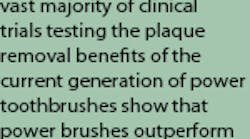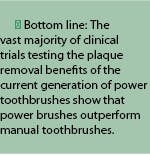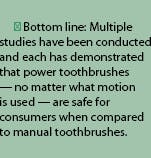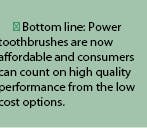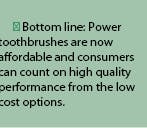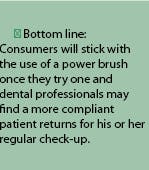Your patients are asking ... Do you have up-to-the-minute information to respond to their questions about power toothbrushes? Several misconceptions still abound. Here’s what you need to know to separate fact from fiction ...
Power toothbrushes have been available for decades, but only recently have seen explosive growth, now accounting for about 40 percent of all toothbrush sales. A quick scan of your local drugstore aisle reveals a large and confusing array of choices.
No doubt many of your patients have tried them, or want to try them, yet how much do they - and you - really know about the current generation of power brushes? Can you confidently guide your patients when they ask about effectiveness, safety, and which brush is right for them? Read on to learn about the research that will help you dispel outdated or inaccurate information about power toothbrushes.
Misconception No. 1:
There’s no real difference in plaque removal between manual toothbrushes and power toothbrushes.
Reality: Every hygienist knows thorough plaque removal is essential for optimal oral health, and research has shown this can be achieved with use of a manual toothbrush and good brushing technique. But in the early 1960s, consumers were given an alternative toothbrushing option with the introduction of electric toothbrushes. Research on the plaque removal effectiveness of these bulky, expensive, early models was inconclusive, leading most dental professionals to shy away from recommending them to patients.
Fast forward to 2005, and the picture has changed dramatically. The electric toothbrush has evolved into the “power” toothbrush, encompassing the higher priced rechargeable models as well as the low cost battery-powered toothbrushes. Brush head and bristle designs are more advanced, based on oscillating/translating, vibrating, or ultrasonic technology.
A wealth of new research - with a few exceptions - supports that the current generation of power brushes removes more plaque than manual toothbrushes in a variety of clinical trial models. These studies have been well designed, meaning that participants were randomly assigned to either the power or manual toothbrush group, brushing regimens were standardized, and plaque examinations were performed by a clinical grader unaware of what type of toothbrush was used. Importantly, these studies produced relatively consistent conclusions.
Because manual toothbrushes differ in their abilities to remove plaque, a multitude of brushes from different manufacturers and with varying head and bristle configurations have been tested relative to power toothbrushes. In general, manual brushes are inferior to the power toothbrushes for plaque control. Even the most sophisticated of designs with manual toothbrushes remove significantly less plaque than battery powered toothbrushes.
What plaque removal benefits have been clinically observed when comparing manual toothbrushes to power toothbrushes? A sample of study results from various sectors of the power brush market reveals similarities: Powered toothbrushes, whether powered by batteries or one of the more upscale versions, provide anywhere from 10 to 49 percent greater plaque removal than manual brushes in single-use trials.
A comprehensive review by the independent Cochrane Collaboration of 29 clinical trials conducted over 37 years and including over 2,500 participants found that rotational oscillation power toothbrushes removed an average of up to 11 percent more plaque than the manual toothbrushes. None of the battery-power toothbrushes now marketed were included in this 2001 review.
Misconception No. 2:
There is a higher incidence of gingival injuries, tooth abrasion and gum recession with power toothbrushes when compared to manual brushes.
Reality: The design of the power toothbrush head, its portability (such as cords and chargers) and the softness of the bristles contribute to the ease of use, effectiveness, and safety of the current brushes.
One advantage of power toothbrushes is that significantly less force is needed to effectively remove plaque than is required for manual toothbrushes. Evidence suggests that the forces used with power toothbrushes are in the 80 to190 g/f range, compared to forces in excess of 250 g/f with manual brushes. The findings from these studies suggest that power toothbrushes are less likely to cause dental and gingival abrasion.
Three studies looked at the number of gingival abrasions that occurred with the use of the Braun/Sonicare power toothbrushes. No damage was reported following the use of any of these power toothbrushes.
More recently, several studies were conducted to test the safety of the battery powered toothbrushes, such as the Crest SpinBrush and the Colgate Actibrush, and a manual brush found that all three brushes were well-tolerated by 82 percent of participants. The results also demonstrated that the power toothbrushes were less injurious to the oral soft tissues than the manual brush. The results of another study indicated that two battery powered toothbrushes were as safe on hard and soft intraoral tissues as the manual toothbrush.
Finally, a four-week safety study involving 140 subjects was conducted at Tufts University to compare a low-cost powered toothbrush to two manual brushes. The results demonstrated no significant differences between the groups, suggesting that the power toothbrush was at least as safe as two leading manual toothbrushes.
Findings of several short-term safety studies reveal there is no more risk for gingival abrasion or recession with a power toothbrush than with a manual toothbrush. Few longer-term safety studies have been conducted on power brushes. A longitudinal study comparing the Interplak® counter-rotational brush to a manual toothbrush assessed the occurrence of gingival abrasion and gingival recession over a 12-month period. At the conclusion, the occurrence of gingival recession was not a factor in either group. Probing depths generally remained stable and no significant differences were found. The bristles of the power toothbrush were shown to be as gentle as the manual brush. Few areas of gingival injury were found and complaints from subjects were minor. What makes this study stand out is not only the 12 month duration, but also the three-minute controlled brushing time used.
Misconception No. 3:
Power toothbrushes are only suited for special patient populations.
Reality: Extensive research has demonstrated that power toothbrushes have many advantages over manual toothbrushes for specific populations, including orthodontic patients, persons with impaired dexterity, children and adolescents, patients with hard to access areas such as dental implants, and periodontal patients with low home-care compliance. For example, patients with fixed orthodontic brackets who face the challenge of adequate plaque control have been shown in at least eight clinical trials to reap superior plaque benefits with a power toothbrush. Gingivitis and/or pocket depth improvement were also demonstrated. Similarly, children with poor oral hygiene have met with significantly greater plaque removal in at least two clinical trials with power toothbrushes.
As the clinical evidence mounts that power brushes have the potential to deliver superior plaque removal, dental professionals are increasingly recommending the use of power toothbrushes for all segments of their patient base. Benefits beyond plaque removal strengthen the case for power toothbrushes. Consider that after 30 days or more of brushing, power toothbrushes, including the Oral-B Plaque Remover, Rowenta Dentiphant, and Colgate Actibrush, were found superior in reducing existing gingivitis over manual toothbrushes by 8 to 40 percent. The power Oral-B 3-D Excel reduced gingivitis an average of 23 percent compared with baseline over a three-month period. And after a one-month investigation, participants using the Crest Spinbrush reaped an average 62 percent reduction in pre-study gingival bleeding sites.
Power toothbrushes have also been shown to deliver better stain removal and tooth whitening than manual brushes. These esthetic benefits appeal to the appearance-conscious public enamored with whitening products.
In a laboratory stained pellicle removal test, the Crest Spinbrush Pro was superior in increasing tooth lightness when compared to a manual toothbrush. In two separate clinical trials of induced chlorhexidene and/or tea stain, two Braun power brushes removed more stain than a manual brush in a single use study; similarly, greater amounts of stain were removed by the power Sonicare brush compared with the manual brushes in the second trial. Stain reductions up to 82 percent were reported by participants using the Crest Spinbrush and Sonicare Plus power brushes in two independent studies.
Clearly, research shows power toothbrushes outshine their manual counterparts.
Misconception No. 4
For the best results, I must purchase one of the expensive power toothbrushes.
Reality: The power toothbrush market has experienced explosive growth since 1999, with retail purchases doubling and now exceeding $847 million in annual sales. While historically these brushes were often cost-prohibitive, the introduction of lower cost power toothbrushes has opened the door to everyone. Yet confusion still reigns when people must decide how much to spend on a power toothbrush. Surprisingly, in the world of power toothbrushes, a big price tag does not necessarily mean better.
Several clinical studies demonstrated that some of the most affordable power brushes - those in about the $10 range - perform as well as or better than the expensive brushes in removing plaque.
The Crest Spinbrush models and Colgate Actibrush generally are sold retail for under $10 in the United States. While the highest priced power brushes often utilize advanced oscillating and ultrasonic features, new research demonstrates that the oscillating and translating brush head design of a lower cost battery power brush can be equally or more effective in combating plaque.
The average price of power toothbrushes has been reduced by half in the last few years, and consumers can now affordably access the benefits of power toothbrush technology with the lower cost options. For those who choose a more economical battery-powered brush, does it make any difference which one they select?
Research is demonstrating that there are differences in brush performance in the under $10 category. In a 2003 university crossover clinical trial, participants using two different types of battery powered brushes had an average of 20.2 percent less plaque after a single use with one of the brushes.
While high-priced models have been consistently effective, lower cost models such as Crest SpinBrush are specifically developed to provide a reasonably priced alternative without sacrificing quality. When the Crest SpinBrush was introduced, it accounted for almost half of all U.S. power toothbrushes sales. With the removal of high price barriers, consumer are trading up from manual to power toothbrushes in record numbers. The result has been greater accessibility and value for those who want the superior benefits of oral hygiene with power toothbrushes.
Misconception No. 5:
My patients who try power toothbrushes will be more compliant at first but will eventually switch back to manual toothbrushes once the novelty has worn off.
Reality: Results of a large clinical trial of 16,000 participants suggested that adults who switched from a manual toothbrush to a power toothbrush were more satisfied with the effectiveness of the power brush and generally did not switch back after the trial ended. As hygienists know, patient compliance can make or break a self-care regimen.
Several clinical trials have been conducted to test the novelty effect of power toothbrushes and the impact on compliance. Results demonstrated that use of power toothbrushes encouraged patients to brush longer. Longer brushing has been reported to result in an almost linear reduction in plaque. This was true in both children and adults. Consumers perceive power toothbrushing to be easier compared to manual toothbrushing.
Brushing duration was examined in two randomized controlled studies. The first study of 64 adults used a parallel design with two groups: 1) a power toothbrush group and 2) a control manual toothbrush group. Subjects were asked to time brushing in the morning and evening with a stopwatch and to record their times in a diary. Voluntary responses from the power toothbrush users (n=30) suggested they tended to brush longer than with a manual toothbrush.
The second study used the same design with 60 children randomly assigned to one of the groups. Parents were asked to time their children’s brushing in the morning and evening and record the times in a diary. The results indicated that children’s mean brushing times were significantly longer when using the power toothbrush.
Why power toothbrushes provide superior per-formances boils down to two key factors: design advantages and increased user motivation. Power brushes feature complex and intricate bristle motions that can’t be duplicated by a manual brush. Brush head size is generally smaller than the average manual brush, which enhances access to hard-to-reach areas.
With respect to heightened motivation, the perception that these brushes are easier and more fun to use has been documented, and often leads to increased brushing time and frequency. Better cleaning efficiency and longer brushing exposure are powerful dual weapons in improving overall oral health.
A large study was designed to evaluate the potential of a power toothbrush to improve oral hygiene, and to investigate the attitudes of dental professionals and patients toward this brush. Both dentists and dental hygienists (n=3,669) in the United States were selected to participate.
Approximately 80,000 patients also participated in the study that consisted of two phases. First, the dental professional made a subjective clinical evaluation of the patient’s oral health, before and after changing to the power toothbrush. Second, a trained interviewer asked subjects a series of attitude questions after 10 months of power toothbrush use.
A total of 687 patients using the power toothbrush were included in the final analysis. Results showed that 80.5 percent of patients benefited from switching to a power toothbrush. Dental professionals judged their oral health status to have improved somewhat or considerably, and 75 percent of the patient population agreed with that assessment. This study supported the results from previously cited controlled clinical studies, which showed that power toothbrushes are more effective than manual toothbrushes.
Patricia Walters, RDH, MS, is a Senior Scientist/Engineer in the Oral Care Research & Development Division of The Procter & Gamble Company, Cincinnati, OH. She may be contacted at [email protected].
Shelly L. Campbell, RDH, MPH, is a clinical research consultant working and writing from her home in Lee’s Summit, MO. She can be reached at [email protected].
References available upon request.
